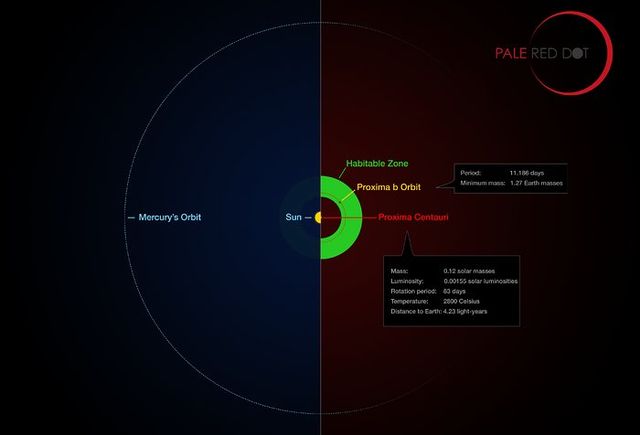Don Barrett
A team of 31 astronomers from 13 institutions around the globe have announced the discovery of a planet slightly more massive than Earth orbiting in the habitable zone of the nearest star to our Solar System. The results were published in Nature on 25 August.
The planet, Proxima b, was discovered by ground-based observations using what is known as the radial velocity method. This method takes advantage of the fact that starlight is a composite of a whole spectrum of colors and that the gravitational tug of a planet on a parent star produces distinct fingerprints in the emitted light that can be observed from Earth. Essentially, one can watch how the motion of a star is influenced by an orbiting planet.
 Proxima Centauri in the sky of the Southern hemisphere. Credit: European Southern Observatory
Proxima Centauri in the sky of the Southern hemisphere. Credit: European Southern Observatory
This method is different from how the Kepler spacecraft discovers exoplanets, which instead looks at periodic drops in the intensity of light coming from a star to infer the existence of a planet, which passes between the star and the observer in its orbit, blocking some of the light. However, the two techniques are complementary. While Kepler indicates roughly an exoplanet’s size, a study of the changing spectrum of a star tells us the lower limit of an exoplanet’s mass.
As a result of this, the astronomers calculated that Proxima b is at least 1.3 times the Earth’s mass, though we have no knowledge yet of its size, its composition or the nature of its atmosphere (if any). Our limited knowledge of solar systems suggests that such a planet would be of rocky composition and retain some sort of atmosphere.
What makes this system most unlike the Earth and Sun is the parent star. Proxima Centauri is a star only 12 percent the mass of the Sun, a “red dwarf”, and this low mass is reflected in vastly different physical characteristics. The star is about 12 percent the Sun’s size, half its temperature and a fraction of its brightness. Despite the fact that it is the nearest star to our Solar System, Proxima Centauri is 100 times too faint to see with the naked eye.
Since Proxima Centauri is so dim, its habitable zone, the orbit where liquid water could exist on a planet’s surface, is much closer to the star than the Sun’s. Proxima b, which orbits its star at 5 percent the distance between the Earth and Sun, about 4.6 million miles, falls within that zone. It receives about 60 percent of the radiation that Earth does.
Such a close world would find its rotation locked to its orbit over a timescale short compared to the life of the system—just as Mercury is locked to our Sun and the Moon to the Earth. Depending on the nature of the lock, it could be that only one hemisphere is illuminated, the other remaining in perpetual darkness, just as the Moon shows only one face to the Earth.
 A comparison of the Proxima Centauri system to our own Solar System. Credit: European Southern Observatory
A comparison of the Proxima Centauri system to our own Solar System. Credit: European Southern Observatory
Another possibility is that the orbit and rotation are intertwined such that the same face of the planet is aligned to the star during the planet’s closest approach. This would mean that if liquid water exists, it may occur only near the Equator or towards the center of a perpetually sunlit hemisphere.
The close orbit produces another challenge to potential habitability: while the star, even so near, provides less heat than the Sun, it can irradiate the planet’s surface irregularly with ultraviolet and x-ray bursts 400 times that delivered by the Sun to Earth. The impact on the planet’s atmosphere over the long term is unknown.
If human beings set foot on Proxima b, they will find the view of the sky considerably different from that on Earth. Proxima would appear three times the Sun’s size in the sky. The nearby binary components of Alpha Centauri A and B would outshine our own Venus by a factor of 10, and appear to the eye as a barely resolvable star-like pair. Other stars would be invisible from the star-lit side of the planet.
The discovery of Proxima b comes 21 years after the first detection of a planet around another ordinary star. In that time, over 3,500 such planets have been found. Nearly 1 billion stars have now been cataloged, but detection of the smaller, lighter and immensely fainter planets around them represents a considerable technical challenge. This is true for all methods of finding exoplanets.
The nearness of Proxima b means it stands as a sterling target for further inquiry toward an understanding of Earth-like worlds. It has also ignited the imagination of millions of people around the world as they wonder at a planet potentially like Earth that is, with some esoteric but feasible ideas for space travel, not so far away.
No comments:
Post a Comment